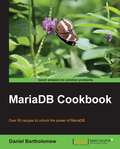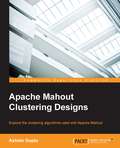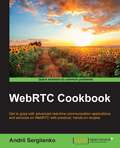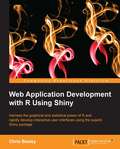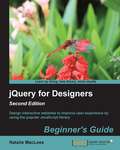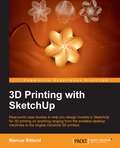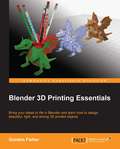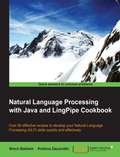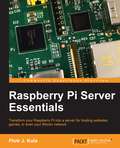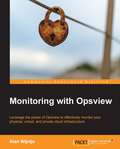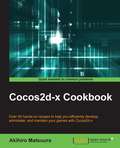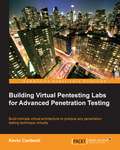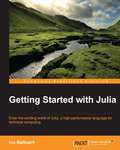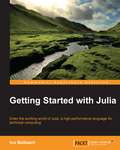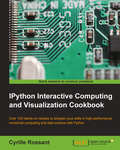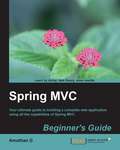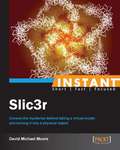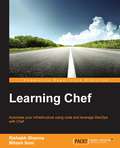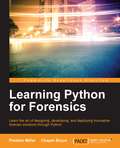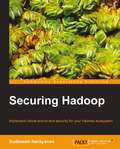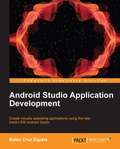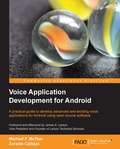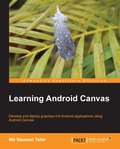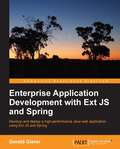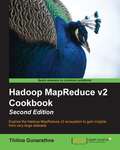- Table View
- List View
MariaDB Cookbook
by Daniel BartholomewA practical cookbook, filled with advanced recipes , and plenty of code and commands used for illustration,which will make your learning curve easy and quick. This book is for anyone who wants to learn more about databases in general or MariaDB in particular. Some familiarity with SQL databases is assumed, but the recipes are approachable to almost anyone with basic database skills.
Apache Mahout Clustering Designs
by Ashish GuptaExplore clustering algorithms used with Apache Mahout About This Book * Use Mahout for clustering datasets and gain useful insights * Explore the different clustering algorithms used in day-to-day work * A practical guide to create and evaluate your own clustering models using real world data sets Who This Book Is For This book is for developers who want to try out clustering on large datasets using Mahout. It will also be useful for those users who don't have background in Mahout, but have knowledge of basic programming and are familiar with basics of machine learning and clustering. It will be helpful if you know about clustering techniques with some other tool. What You Will Learn * Explore clustering algorithms and cluster evaluation techniques * Learn different types of clustering and distance measuring techniques * Perform clustering on your data using K-Means clustering * Discover how canopy clustering is used as pre-process step for K-Means * Use the Fuzzy K-Means algorithm in Apache Mahout * Implement Streaming K-Means clustering in Mahout * Learn Spectral K-Means clustering implementation of Mahout In Detail As more and more organizations are discovering the use of big data analytics, interest in platforms that provide storage, computation, and analytic capabilities has increased. Apache Mahout caters to this need and paves the way for the implementation of complex algorithms in the field of machine learning to better analyse your data and get useful insights into it. Starting with the introduction of clustering algorithms, this book provides an insight into Apache Mahout and different algorithms it uses for clustering data. It provides a general introduction of the algorithms, such as K-Means, Fuzzy K-Means, StreamingKMeans, and how to use Mahout to cluster your data using a particular algorithm. You will study the different types of clustering and learn how to use Apache Mahout with real world data sets to implement and evaluate your clusters. This book will discuss about cluster improvement and visualization using Mahout APIs and also explore model-based clustering and topic modelling using Dirichlet process. Finally, you will learn how to build and deploy a model for production use. Style and approach This book is a hand's-on guide with examples using real-world datasets. Each chapter begins by explaining the algorithm in detail and follows up with showing how to use mahout for that algorithm using example data-sets.
WebRTC Cookbook
by Andrii SergiienkoIf you are a JavaScript developer with a basic knowledge of WebRTC and software development, but want to explore how to use it in more depth, this book is for you.
Web Application Development with R using Shiny
by Chris BeeleyThis book follows a standard tutorial-based approach which will teach you how to make a web app using R and Shiny quickly and easily.This book is for anybody who wants to produce interactive data summaries over the Web, whether you want to share them with a few colleagues or the whole world. You need no previous experience with R, Shiny, HTML, or CSS to begin using this book, although you will need at least a little previous experience with programming in a different language.
jQuery for Designers: Second Edition
by Natalie MacleesA step-by-step guide that spices up your web pages and designs them in the way you want using the most widely used JavaScript library, jQuery. The beginner-friendly and easy-to-understand approach of the book will help get to grips with jQuery in no time. If you know the fundamentals of HTML and CSS, and want to extend your knowledge by learning to use JavaScript, then this is just the book for you. jQuery makes JavaScript straightforward and approachable - you'll be surprised at how easy it can be to add animations and special effects to your beautifully designed pages.
3D Printing with SketchUp
by Marcus RitlandThis book is a practical tutorial, packed with real-world case studies to help you design models that print right the first time. If you are familiar with SketchUp and want to print the models you've designed, then this book is ideal for you. You don't need any experience in 3D printing; however, SketchUp beginners will require a companion book or video training series to teach them the basic SketchUp skills.
Blender 3D Printing Essentials
by Gordon FisherThis book adopts a practical approach, with the use of step-by-step instructions to help guide readers. There are lots of screenshots covering each and every step needed to design a high-quality model in Blender for 3D printing.If you are a Blender user or someone who wants to use Blender to make 3D objects suitable for 3D printing, this book is ideal for you. You should already be comfortable with basic modeling in Blender - including using modifiers - although advanced skills are not required. All of the models that you will need are explored in-depth. This book does not assume that you will use any specific printer and teaches the general principles common to building models for most printers. It also gives you tips on discovering the requirements of the specific printer you will be using.
Natural Language Processing with Java and LingPipe Cookbook
by Krishna Dayanidhi Breck BaldwinThis book is for experienced Java developers with NLP needs, whether academics, industrialists, or hobbyists. A basic knowledge of NLP terminology will be beneficial.
Raspberry Pi Server Essentials
by Piotr J. KulaThis is an engaging, easy to follow guide for developing a wide range of server projects with Raspberry Pi This book is targeted towards all Raspberry Pi enthusiasts who are interested in exploring the potential of Pi as a server. Even if you have no prior experience with the Raspberry Pi, you can pick up this book and develop a wide range of projects.
Monitoring with Opsview
by Alan WijntjeA practical and fast-paced guide that gives you all the information you need to get up and running with Opsview.This book is for anyone interested in using Opsview as a potential monitoring solution or for those who are already running Opsview Core and who would like to improve on their setup by exploring the features of Pro and Enterprise. Some working knowledge of monitoring and Linux is assumed, and it is recommended to have an Opsview system at hand while reading, allowing you to immediately try out the features discussed.
Cocos2d-x Cookbook
by Akihiro MatsuuraOver 50 hands-on recipes to help you efficiently administer and maintain your games with Cocos2d-xAbout This BookBuild exciting games, apps, and other cross-platform GUI based interactive programs with Cocos2d-xExplore the nitty-gritty of the latest Cocos2d-x on the block, version 3.6A step-by-step guide that shows you the functionalities of Cocos2d-x followed by an explanation of how they workWho This Book Is ForIf you are a game developer and want to learn more about cross-platform game development in Cocos2d-x, then this book is for you. Knowledge of C++, Xcode, Eclipse, and how to use commands in the terminal are prerequisites for this book.What You Will LearnInstall and set up Cocos2d-x for your development environmentBuild, test, and release game applications for iOS and AndroidDevelop your games for multiple platformsCustomize Cocos2d-x for your gamesUse a physical engine in your gamesSave and load text, JSON, XML, or other formatsExplore the brand new features of Cocos2d-xIn DetailCocos2d-x is a suite of open source, cross-platform game-development tools used by thousands of developers all over the world. Cocos2d-x is a game framework written in C++, with a thin platform-dependent layer. Completely written in C++, the core engine has the smallest footprint and the fastest speed of any other game engine, and is optimized to be run on all kinds of devices.You will begin with the initial setup and installation of Cocos2d before moving on to the fundamentals needed to create a new project. You will then explore and create the sprites, animations, and actions that you will include in the game. Next you will look at strings and create labels, including a label with True Type Font (TTF) font support.Later, you will learn about layer and scene creation and transition. Then you will create the GUI parts essential for a game, such as buttons and switches. After that, you will breathe life into the game with background music and sound effects using the all new Cocos2d-x audio engine. You will then discover how to manage resource files and implement processes that depend on the operating system.Finally, you will polish your game with physics such as gravity and elevation, learn about tools that will help you make games more robust and stable, and get to know best practices to improve the game you have developed.Style and approachThis book is an easy-to-follow guide with ample recipes to help you better understand Cocos2d-x.
Building Virtual Pentesting Labs for Advanced Penetration Testing
by Kevin CardwellWritten in an easy-to-follow approach using hands-on examples, this book helps you create virtual environments for advanced penetration testing, enabling you to build a multi-layered architecture to include firewalls, IDS/IPS, web application firewalls, and endpoint protection, which is essential in the penetration testing world.If you are a penetration tester, security consultant, security test engineer, or analyst who wants to practice and perfect penetration testing skills by building virtual pentesting labs in varying industry scenarios, this is the book for you. This book is ideal if you want to build and enhance your existing pentesting methods and skills. Basic knowledge of network security features is expected along with web application testing experience.
Getting Started with Julia
by Ivo Balbaert<P><P>Enter the exciting world of Julia, a high-performance language for technical computing <P><P>About This Book <P><P>Work with Julia in a multi-core, distributed, and networked environment <P><P>Learn the techniques to create blazingly fast programs with Julia <P><P>The book walks you through various practical examples to get to grips with Julia <P><P>Who This Book Is For <P><P>This book is for you if you are a data scientist or working on any technical or scientific computation projects. The book assumes you have a basic working knowledge of high-level dynamic languages such as MATLAB, R, Python, or Ruby. <P><P>What You Will Learn <P><P>Set up your Julia environment to achieve the highest productivity <P><P>Solve your tasks in a high-level dynamic language and use types for your data only when needed <P><P>Create your own types to extend the built-in type system <P><P>Visualize your data in IJulia with plotting packages <P><P>Explore the use of built-in macros for testing, debugging, benchmarking, and more <P><P>Apply Julia to tackle problems concurrently and in a distributed environment <P><P>Integrate with other languages such as C, Python, and MATLAB <P><P>In Detail <P><P>Julia is a new open source programming language that is used in the field of data science computing. It was created to solve the dilemma between high-level slow code and fast but low-level code, and the necessity to use both to achieve high performance. This book will give you a head start to tackle your numerical and data problems with Julia. Your journey will begin by learning how to set up a running Julia platform before exploring its various built-in types. You will then move on to cover the different functions and constructs in Julia. The book will then walk you through the two important collection types―arrays and matrices. Over the course of the book, you will also be introduced to homoiconicity, the meta-programming concept in Julia. <P><P>Towards the concluding part of the book, you will also learn how to run external programs. This book will cover all you need to know about Julia to leverage its high speed and efficiency.
Getting Started with Julia Programming
by Ivo BalbaertThis book is for you if you are a data scientist or working on any technical or scientific computation projects. The book assumes you have a basic working knowledge of high-level dynamic languages such as MATLAB, R, Python, or Ruby.
IPython Interactive Computing and Visualization Cookbook
by Cyrille RossantIntended to anyone interested in numerical computing and data science: students, researchers, teachers, engineers, analysts, hobbyists... Basic knowledge of Python/NumPy is recommended. Some skills in mathematics will help you understand the theory behind the computational methods.
Spring MVC Beginner’s Guide
by Amuthan GA step-by-step pragmatic approach to web application development using Spring MVC, with relevant screenshots and concise explanations. This book is aimed at helping Java developers who want to teach themselves Spring MVC, even if they have no previous experience with Spring MVC. It would be helpful to have a bit of familiarity with basic servlet programming concepts, but no prior experience is required.
Instant Slic3r
by David Michael MooreFilled with practical, step-by-step instructions and clear explanations for the most important and useful tasks. Instant Slic3r follows a practical, recipe-based approach that will show you how to complete the various steps to turn 3D models into actual objects with a 3D printer.Instant Slic3r is for people new to 3D printing and its software, and also for people who are new to Slic3r. You will need to know the basics of 3D printing, and how to use your printer and the other software associated with it.
Learning Chef
by Mitesh Soni Rishabh SharmaIf you are a system administrator, Linux administrator, cloud developer, cloud administrator, or someone who just wants to learn and apply Chef automation to your existing or new infrastructure, this book is for you. Some real-time understanding of IT processes and familiarity with Linux systems, Ruby, and JSON is essential.
Learning Python for Forensics
by Preston Miller Chapin BryceLearn the art of designing, developing, and deploying innovative forensic solutions through Python About This Book * This practical guide will help you solve forensic dilemmas through the development of Python scripts * Analyze Python scripts to extract metadata and investigate forensic artifacts * Master the skills of parsing complex data structures by taking advantage of Python libraries Who This Book Is For If you are a forensics student, hobbyist, or professional that is seeking to increase your understanding in forensics through the use of a programming language, then this book is for you. You are not required to have previous experience in programming to learn and master the content within this book. This material, created by forensic professionals, was written with a unique perspective and understanding of examiners who wish to learn programming What You Will Learn * Discover how to perform Python script development * Update yourself by learning the best practices in forensic programming * Build scripts through an iterative design * Explore the rapid development of specialized scripts * Understand how to leverage forensic libraries developed by the community * Design flexibly to accommodate present and future hurdles * Conduct effective and efficient investigations through programmatic pre-analysis * Discover how to transform raw data into customized reports and visualizations In Detail This book will illustrate how and why you should learn Python to strengthen your analysis skills and efficiency as you creatively solve real-world problems through instruction-based tutorials. The tutorials use an interactive design, giving you experience of the development process so you gain a better understanding of what it means to be a forensic developer. Each chapter walks you through a forensic artifact and one or more methods to analyze the evidence. It also provides reasons why one method may be advantageous over another. We cover common digital forensics and incident response scenarios, with scripts that can be used to tackle case work in the field. Using built-in and community-sourced libraries, you will improve your problem solving skills with the addition of the Python scripting language. In addition, we provide resources for further exploration of each script so you can understand what further purposes Python can serve. With this knowledge, you can rapidly develop and deploy solutions to identify critical information and fine-tune your skill set as an examiner. Style and approach The book begins by instructing you on the basics of Python, followed by chapters that include scripts targeted for forensic casework. Each script is described step by step at an introductory level, providing gradual growth to demonstrate the available functionalities of Python.
Securing Hadoop
by Sudheesh NarayananThis book is a step-by-step tutorial filled with practical examples which will focus mainly on the key security tools and implementation techniques of Hadoop security.This book is great for Hadoop practitioners (solution architects, Hadoop administrators, developers, and Hadoop project managers) who are looking to get a good grounding in what Kerberos is all about and who wish to learn how to implement end-to-end Hadoop security within an enterprise setup. It's assumed that you will have some basic understanding of Hadoop as well as be familiar with some basic security concepts.
Android Studio Application Development
by Belen Cruz ZapataA practical guide, which will show you how to create Android applications using the new Google official IDE, Android Studio.If you are a developer who wants to learn the key features of Android Studio, and learn how to create their first app, this book is ideal for you! Developers interested in this book should be familiar with the object- oriented programming paradigm, and the Java programming language. It is also recommended that you understand the main characteristics of the Android mobile system.
Voice Application Development for Android
by Zoraida Callejas Michael F. MctearThis book will give beginners an introduction to building voice-based applications on Android. It will begin by covering the basic concepts and will build up to creating a voice-based personal assistant. By the end of this book, you should be in a position to create your own voice-based applications on Android from scratch in next to no time.Voice Application Development for Android is for all those who are interested in speech technology and for those who, as owners of Android devices, are keen to experiment with developing voice apps for their devices. It will also be useful as a starting point for professionals who are experienced in Android application development but who are not familiar with speech technologies and the development of voice user interfaces. Some background in programming in general, particularly in Java, is assumed.
Learning Android Canvas
by Mir Nauman TahirThis book is a fast-paced, practical, step-by-step tutorial guide full of examples that are easy to follow and implement.This book is a great resource for developers who have basic Android development knowledge and want to work on graphics-rich applications and games but are totally new to working with graphics and Android Canvas.
Enterprise Application Development with Ext JS and Spring
by Gerald GiererAn easy-to-follow tutorial, that breaks down the enterprise application development journey into easy to understand phases documented by clear examples and concise explanations.If you are an intermediate developer with a good understanding of Java, JavaScript and web development concepts, this book is ideal for you. Basic ExtJS development experience, including an understanding of the framework APIs is needed by those of you who are interested in this book. Regardless of your experience and background, the practical examples provided in this book are written in a way that thoroughly covers each concept before moving on to the next chapter.
Hadoop MapReduce v2 Cookbook - Second Edition
by Thilina GunarathneIf you are a Big Data enthusiast and wish to use Hadoop v2 to solve your problems, then this book is for you. This book is for Java programmers with little to moderate knowledge of Hadoop MapReduce. This is also a one-stop reference for developers and system admins who want to quickly get up to speed with using Hadoop v2. It would be helpful to have a basic knowledge of software development using Java and a basic working knowledge of Linux.
